While you might think that loops and samples are just two terms for the same thing, they actually play very different roles in music production.
You’ll find that loops are your go-to for creating a consistent rhythmic pattern—a repetitive series of beats or melodies that serve as the backbone of your track.
On the other hand, samples are the unique sound bites you insert for flavor and flair, whether they’re short vocal chops or a fragment of an instrument. They’re the individual notes, drum hits, or short fx that, when combined with your loops, can help you create a professional song.
By understanding the distinction between loops and samples, you’re well on your way to crafting tracks that resonate with your personal style.
If you are looking to download free samples and loops, check out this massive library of the best free sample packs.
Key Takeaways
- Loops provide rhythm and structure, while samples add unique character and sound to tracks.
- Loops create a consistent sonic background, while samples add distinct sonic flavors.
- Loops serve as the rhythmic foundation, while samples provide moments of surprise and delight.
- Loops and samples together create limitless soundscapes.
Understanding the Basics: Loops and Samples in Music
When you’re working with loops in music production, you’re dealing with segments of sound designed to be played repeatedly to form a consistent sonic background.
In contrast, samples are individual audio clips that you manipulate to infuse your track with distinct flavors, whether they’re lifted from pre-existing recordings or captured from unique sound sources.
Both tools are essential in modern music-making, offering you a palette of sounds for crafting rhythms, melodies, and textures with precision and creative flexibility.
If you’re intrigued by the distinctions and roles of loops and samples in music production, you might find it helpful to explore more detailed insights. For a comprehensive understanding of how loops and samples differ and how they can be used effectively in your music projects, check out this detailed exploration at What Is the Difference Between Loops and Samples.
Definition of Loops in Music Production
While exploring the world of music production, you’ll find that loops are essential building blocks that provide rhythm and structure to your tracks by repeating a musical phrase over a set number of bars.
A drum loop, for example, can lay down the backbone for a piece, with kick, snare, and cymbal patterns cycling to create a steady groove.
Looping in music isn’t just confined to percussion; melodic and harmonic elements can also be looped to establish a motif or ambiance.
When you make loops, precision is key—timing and seamless repetition are crucial for maintaining the integrity of the beat or melody.
A loop station, or software equivalent, enables you to manipulate and layer these loops, crafting complex arrangements from simple, repetitive sequences.
Definition of Samples in Music
You’ll often come across the term ‘samples’ in music production, referring to individual pieces of audio that you can cut into and weave throughout your tracks to add unique character and sound. These samples range from brief one shots—such as a singular kick drum or a cymbal crash—to longer segments that might capture a full musical phrase.
When using sampled sounds, you’re engaging in sound design, meticulously sculpting the timbre and texture of your music. Each sample serves a purpose, whether it’s to inject a real-world feeling with recordings of actual instruments or to create entirely new sonic landscapes.
Unlike loops, which often provide a repetitive backbone, samples grant you the freedom to innovate, allowing for a more granular manipulation of audio elements within your compositions.
The Role of Loops in Music Creation

In your music production workflow, loops serve as the rhythmic and melodic bedrock upon which you construct the layers of your track. You select loops based on their tempo, key, and timbral qualities, ensuring they align with your creative vision and the genre you’re operating within.
Crafting a compelling piece involves strategically sequencing these loops to establish both repetition and dynamic progression throughout your composition.
How Loops Work in Music Production
When you’re building a track, incorporating loops can streamline the creative process by laying down a solid rhythmic or melodic foundation to build upon. In music production, loops are critical components that can be seamlessly repeated to create a consistent groove or motif. Your digital audio workstation (DAW) is the canvas where loops and samples converge, enabling you to manipulate and layer these elements with precision.
- Efficiency: Loops expedite composition by providing pre-made sections that fit right into your project.
- Creativity: Looping music invites exploration, prompting you to blend genres and textures in innovative ways.
- Consistency: Loops ensure rhythmic and harmonic steadiness, giving your tracks a professional polish.
The Process of Making and Using Loops in Music
As a music producer, you’ll find that creating loops involves recording or programming a sequence of sounds that seamlessly repeat to form the rhythmic or melodic backbone of a track. When you’re using a loop, you’re engaging in a loop-based method to create a song. This is where using MIDI can become particularly powerful, allowing for precise control and manipulation of loops together.
| Technique | Emotional Impact | Usage |
|---|---|---|
| Layering Loops | Generates Depth | Building Texture |
| Altering Tempo | Evokes Urgency | Modulating Energy |
| Tweaking Pitch | Shifts Mood | Crafting Harmony |
Exploring the World of Samples
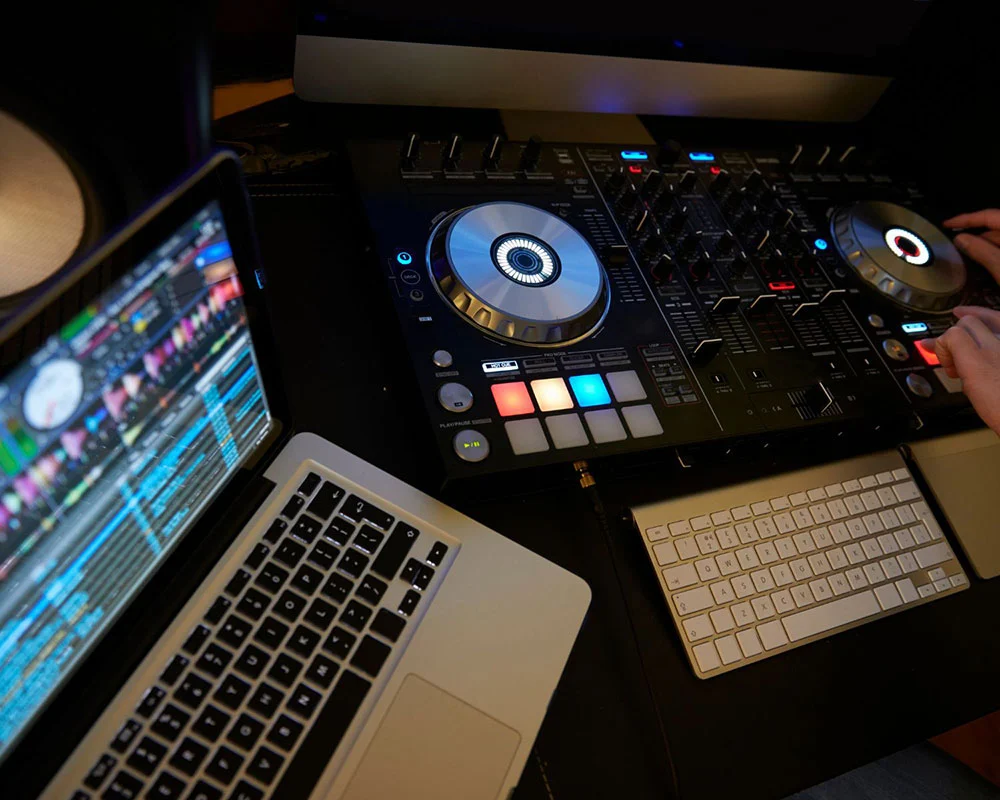
As you venture into the realm of samples, you’ll encounter diverse types such as one-shots and music samples, each with unique applications.
One-shots are singular hits used for crafting patterns or enhancing a track’s depth, while music samples, often longer and more complex, can be seamlessly integrated to enrich a composition’s texture.
Mastering techniques for recording and customizing these samples is crucial, enabling precise manipulation and tailoring to fit your musical vision.
Different Types of Samples: One-shots vs. Music Samples
In your exploration of the world of samples, you’ll find that every one-shot offers a unique element to a track, while music samples can provide a more extensive section for looping and manipulation. One-shot samples, especially drum samples, are crucial in sound design, offering distinct, singular sounds that punctuate and give life to rhythms. Music samples, on the other hand, might encompass a full chord progression, a melody, or a complex drum loop, providing rich layers that can be creatively repurposed.
- The crisp snap of a one-shot snare that cuts through the mix.
- A haunting piano music sample loop that sets an emotive foundation.
- The versatility of one-shots in sculpting the perfect drum pattern.
These elements contribute to a track’s ambiance and energy, demonstrating the interplay between precision and creativity in sample selection.
Techniques for Recording and Customizing Samples
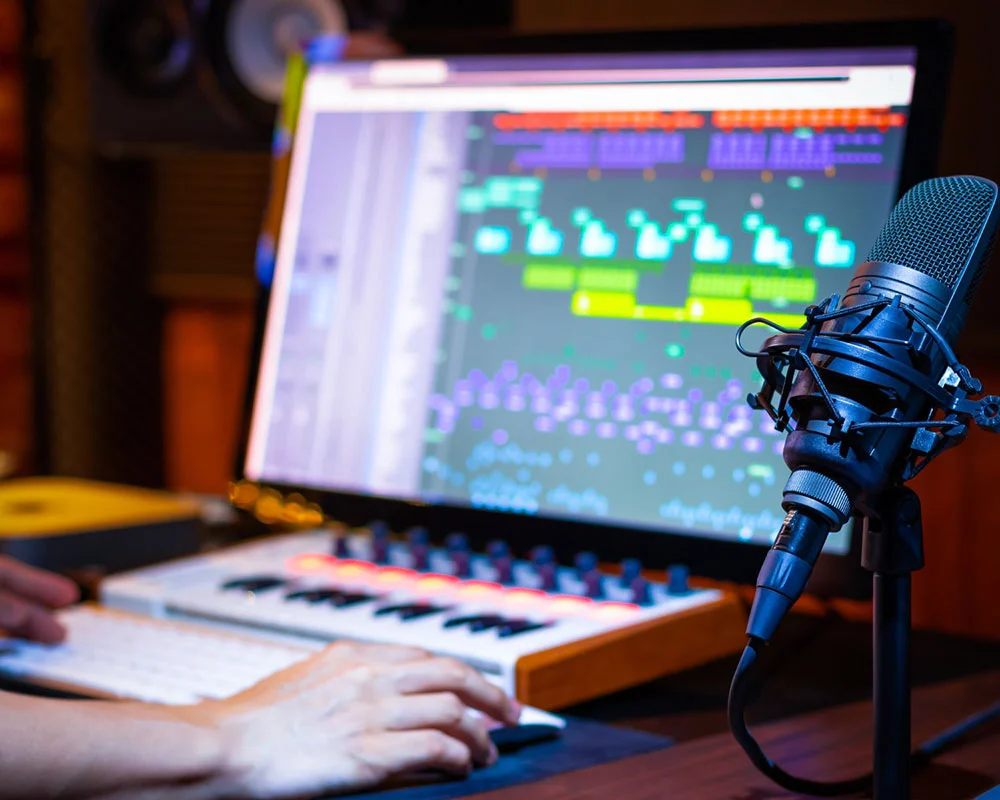
Having explored the variety of samples available, you’re now ready to dive into techniques for recording and customizing your own samples to infuse originality into your music production.
The initial step is selecting your source, which could range from real instruments to environmental sounds. Utilizing high-quality microphones and preamps ensures a pristine capture, essential for professional sound design.
Next, manipulate your recordings using audio editing software. Experiment with pitch-shifting, time-stretching, and applying effects to craft a unique sound. Consider layering multiple samples for added complexity.
To integrate seamlessly into music with a loop, meticulously trim and align your samples to the correct tempo. This attention to detail ensures a cohesive and polished final product, elevating your music production to new heights.
Comparative Analysis: Loops vs. Samples
You’ll find that loops and samples serve distinct functions in music production, with loops providing a consistent rhythmic backbone and samples offering discrete audio elements for creative manipulation.
When you analyze their applications, you’ll see that loops tend to be utilized for maintaining groove continuity, whereas samples are often key for injecting unique sonic flavors and motifs into a track.
Understanding the technical nuances between these two components is crucial to effectively layering and crafting the sonic landscape of your music.
Key Differences Between Loops and Samples
Several key differences exist when you compare loops and samples, each offering distinct advantages depending on your music production goals.
Loops are typically your go-to for establishing a consistent groove within your track, often crafted from sections of percussive patterns or melodic sequences that seamlessly repeat.
Samples, however, are the building blocks that provide the distinct sonic flavors in your composition, whether they’re one-shots fired from a drum machine or a melodic stab from a vintage synthesizer.
- Loops: They’re the backbone, delivering a rhythmic foundation that keeps listeners nodding their heads.
- Samples: They’re the spice, scattering moments of surprise and delight into the auditory feast.
- Creativity: Loops and samples together, they’re the ultimate toolkit for you to sculpt soundscapes limited only by your imagination.
How Loops and Samples Complement Each Other in Music Production
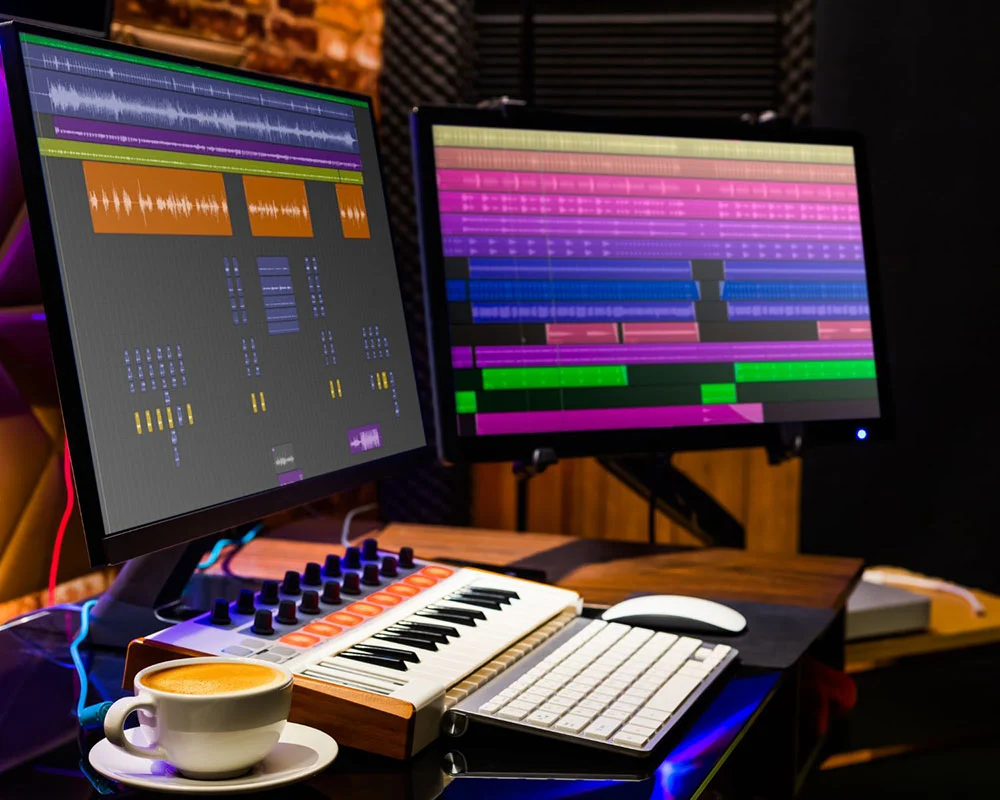
In your music production, both loops and samples serve distinct purposes, yet when combined, they form a synergistic duo that elevates your tracks to new heights. Loops offer a consistent rhythmic backbone, crucial for the structure of electronic music, while samples provide the intricate details that personalize your sound design. Here’s a comparative analysis that showcases how they complement each other in music production:
| Loops | Samples |
|---|---|
| Offer continuity and rhythm | Add unique textures |
| Used for repetitive patterns | Allow for sound manipulation |
| Basis for collaboration in remote music production | Create specific sound elements |
| Provide instant musical inspiration | Contribute to the depth of a song |
| Dependent on algorithm and hardware for efficiency | Require careful selection for accuracy |
Practical Applications: Using Loops and Samples Effectively
You’ll enhance your tracks’ creativity by strategically integrating loops, ensuring they complement your core melodies and rhythms without overwhelming them.
Incorporating samples requires a keen ear for texture and timing; carefully select and manipulate these audio snippets to add depth and character to your music.
How to Integrate Loops into Your Music for Enhanced Creativity
Loop integration, a technique that can elevate your music’s dynamics, involves selecting the right loops to match the energy and style of your track. When you use loops, especially guitar loops, they provide a built-in sense of progression and life. The trick is to ensure everything sounds good together.
Start by anchoring your song around a central loop that captures the mood you’re aiming for.
Craft a rich sonic palette: Incorporate layers that complement the core loop.
Manipulate timing and pitch: Adjust the loop to fit your track’s tempo and key.
Design seamless transitions: Blend loops smoothly to maintain a cohesive sound.
Tips for Incorporating Samples into Your Tracks
Start integrating diverse samples into your music to immediately enrich the texture and complexity of your tracks. Pay close attention to sound design to ensure that samples like the iconic bass line from a Beatles track, for example, mesh well with the parts of the song you’re creating. Here’s a detailed guide to help you:
| Sample Type | Use Case | Technical Tip |
|---|---|---|
| Drum Hits | Rhythm Section | Layer with loops for a fuller beat |
| Vocal Chops | Hooks/Choruses | Pitch and time-stretch for harmony |
| Instrument Riffs | Verses/Bridges | Match the key and tempo of your track |
| Ambient Sounds | Soundscapes | Use reverb and panning for depth |
Just starting out in music production?
Learn how the 7 essential steps for how to become a music producer!
Technical Insights: Looping and Sampling Equipment
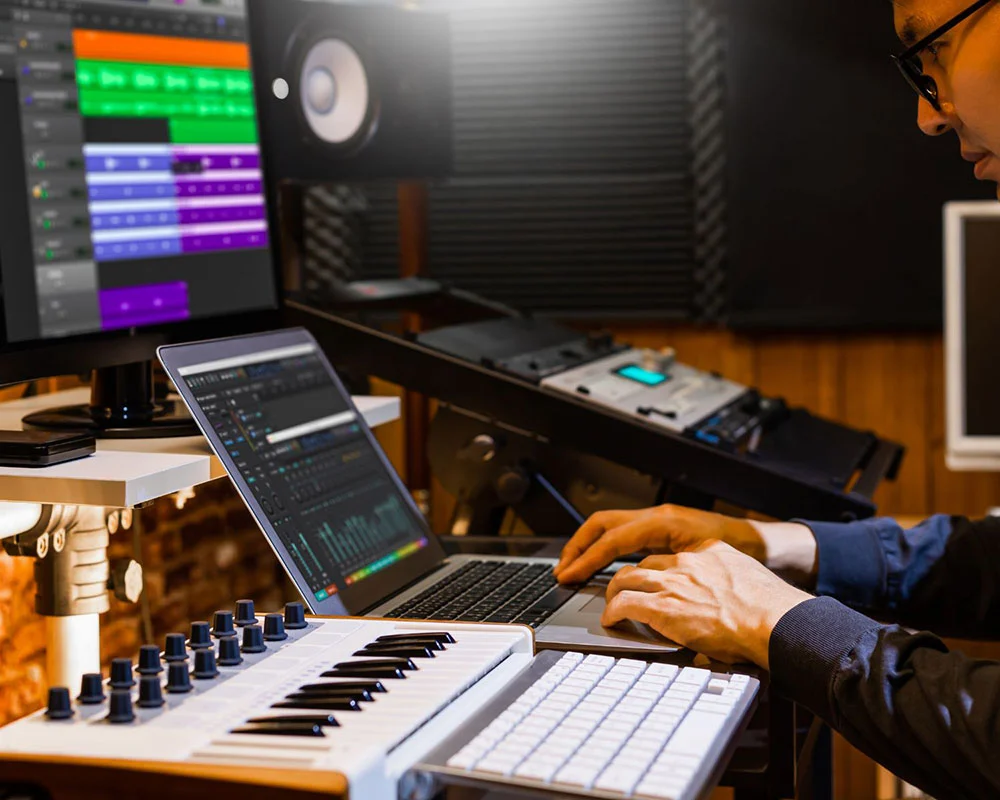
You’ll need specialized hardware and software to engage effectively with looping and sampling in music production.
For looping, sequencers and drum machines with pattern-based interfaces are essential for constructing and manipulating your beats in real-time.
Meanwhile, high-quality samplers and digital audio workstations (DAWs) equipped with robust sampling tools are crucial for chopping, stretching, and layering your samples with precision.
Essential Hardware and Software for Looping
To create your own loops, you’ll need a variety of hardware and software tools designed for music production and sound manipulation.
Essential hardware for looping typically includes:
- Digital Audio Workstation (DAW): A pivotal software platform where you can manipulate and arrange loops and samples to craft music without limitations.
- MIDI Controller: An expressive interface used to create and perform music with virtual instruments, offering tactile control over your loops.
- Audio Interface: A crucial bridge between your instruments, microphones, and your computer, ensuring high-quality sound capture for pristine loops.
Each piece of equipment plays a specific role in the production process, enhancing the potential to innovate and sculpt sound.
Tools and Technology for Sampling in Music
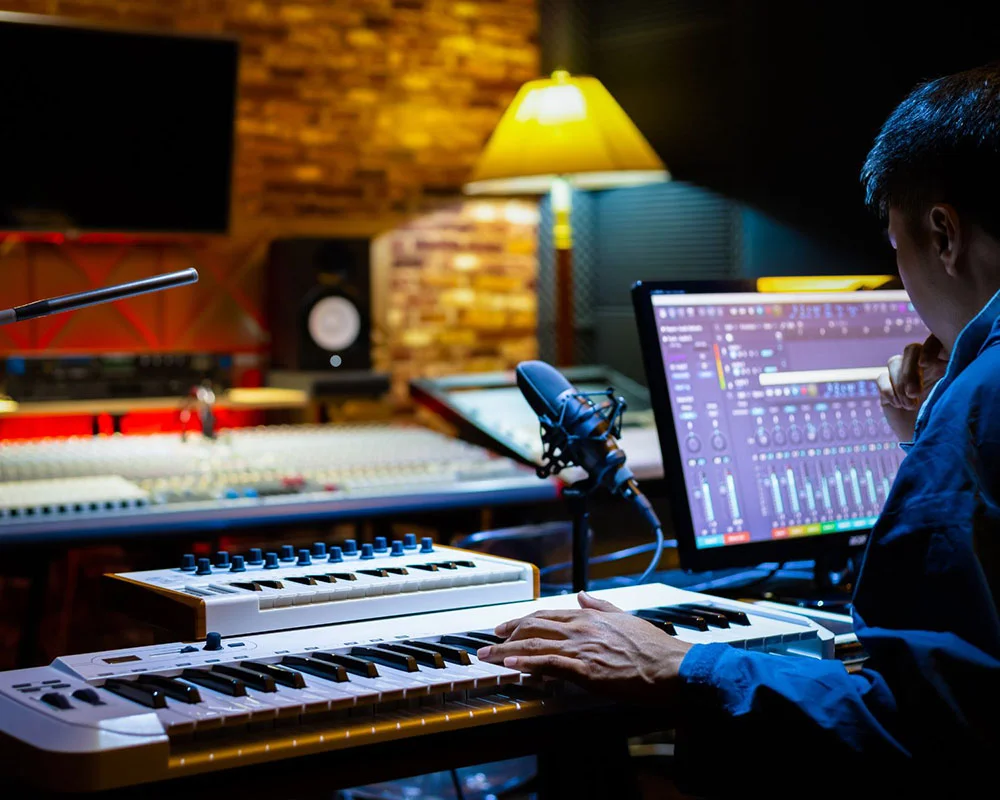
Every producer needs the right tools to effectively sample audio, ensuring your tracks have the distinct texture and quality that set them apart.
In the realm of sound design, sampling is a nuanced art. You’ll need a robust digital audio workstation (DAW) that handles samples with precision, allowing you to slice, warp, and layer sounds seamlessly.
For capturing live elements, such as guitar riffs or percussion, a high-fidelity audio interface and a versatile sampler are indispensable. These devices enable you to record and manipulate audio in real-time.
When integrating loops, your DAW should provide advanced tempo-matching and stretching capabilities to ensure that the loops meld with your project’s tempo and key without losing quality.
Historical Perspective: The Evolution of Looping and Sampling
You’ve witnessed the transformative impact of looping and sampling on music production. These techniques have their roots tracing back to the advent of tape machines and early digital samplers.
Looping, which began as physical tape loops and evolved through software sequencers, has shaped genres by enabling continuous playback of rhythmic and melodic patterns.
Sampling’s progression from crude splicing to advanced time-stretching algorithms has redefined musical boundaries. It allows producers to infuse tracks with diverse sonic fragments from myriad sources.
Case Studies and Industry Examples
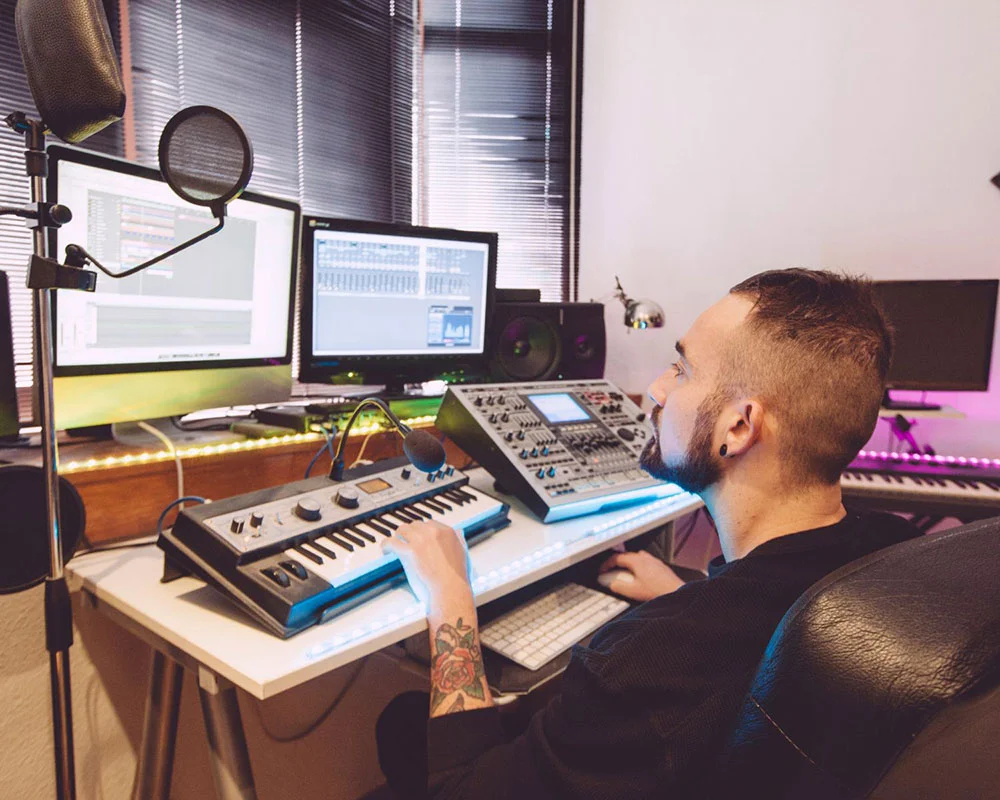
As you explore the realm of music production, you’ll find that loops and samples have been pivotal in shaping the soundscapes of modern music.
Analyze how Daft Punk’s ‘One More Time’ ingeniously utilizes loops for its infectious groove, contrasting with the game-changing sample of the Amen break in hip-hop and jungle music.
These industry examples highlight the transformative power of these tools, influencing composition techniques and spawning new genres.
Famous Examples of Looping in Popular Music
Discover how Dr. Dre revolutionized hip-hop by mastering the art of sampling, turning snippets from classic records into foundational loops for his iconic tracks. His technique involved isolating a segment, often just a few bars long, and looping it endlessly to form the backbone of a new song. This approach not only popularized sample-based music production but also started making longer musical phrases a norm in hip-hop.
- Endless Beats: Dr. Dre’s loops created beats that felt eternal, driving the entire song forward.
- Innovative Phrasing: By extending samples beyond traditional lengths, he crafted a new musical vocabulary.
- Cultural Resonance: His work bridged generations, melding timeless motifs with contemporary rhythms.
Iconic Samples and Their Impact on Music
You’ve seen how Dr. Dre’s sample-based loops became hip-hop staples; now let’s delve into the world of iconic samples that have shaped entire genres and influenced countless artists.
Its important to recognize the pivotal role of sound design in crafting hits. Take Avicii’s ‘Levels’—its sample of Etta James’s powerful vocals propelled the track into legendary status, exemplifying how an iconic sample can define a song’s identity.
In rock, a guitar player’s riff, sampled and looped, can become the anthem for a generation. The impact on music is profound; these samples transcend their origins, becoming ingrained in cultural memory.
Each iconic sample carries a legacy, transforming and inspiring subsequent soundscapes across the industry.
Challenges and Solutions in Looping and Sampling
As you navigate the complexities of looping and sampling, you’ll encounter issues such as the risk of overusing loops, leading to monotonous tracks, or facing legal repercussions from uncleared samples.
To mitigate these challenges, you must employ strategies like varying loop lengths and layers to maintain dynamism, and rigorously ensure sample clearance before commercial use.
Additionally, integrating custom-recorded elements with pre-existing loops can significantly enhance the originality of your productions.
Common Issues Faced When Working with Loops and Samples
When incorporating loops and samples into your music, you’ll often encounter challenges like maintaining originality and navigating copyright laws that require thoughtful solutions.
As a sound designer, you might want to record a guitar player to create a loop that’s precisely four bars long, ensuring it can be easily integrated into your track. However, many artists struggle with:
- Originality Anxiety: The fear that your music will become a carbon copy of others.
- Legal Labyrinth: The dread of unintentional copyright infringement.
- Puzzle Complexity: The frustration when that perfect sample just won’t fit.
To overcome these, delve into your sound design toolkit and manipulate your recordings for a distinct twist. Always secure the rights for any samples used, and remember, the artistry lies in shaping these sounds to tell your unique musical story.
Best Practices for Overcoming These Challenges
Often, you’ll find that creatively manipulating loops and carefully curating samples can significantly mitigate concerns of originality and legal issues in your music production. As a sound designer, you might be wondering how to maintain uniqueness while using loops.
Consider altering the pitch, applying effects, or splicing parts of a loop to make it your own. For instance, a guitar player might want to add a personal touch to a 4-bars long loop by recording a live overlay, thus introducing an organic element.
When sampling, strive for transformative use; manipulate the timbre, rhythm, or melody of a sample to such an extent that it becomes distinct. This approach not only fosters innovation but also helps navigate potential copyright constraints.
The Future of Looping and Sampling in Music
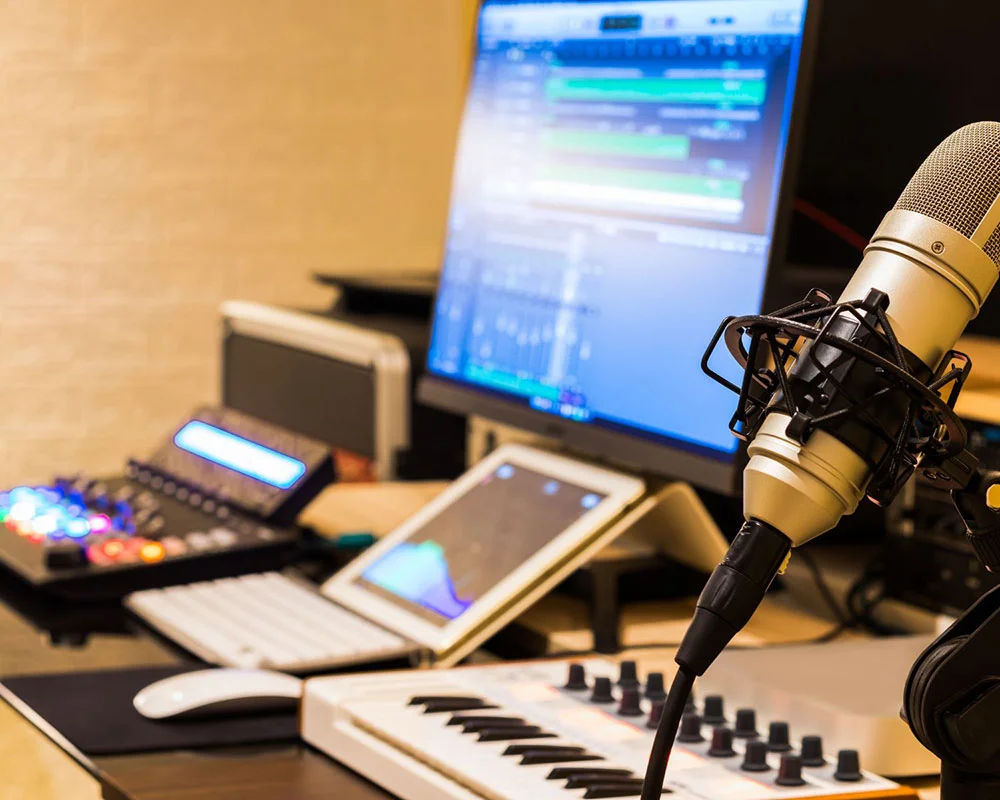
In light of the rapid technological advancements, the future of looping and sampling in music is poised for even greater innovation and expansion. This doesn’t mean the artistry is lost; instead, it evolves. As a sound designer, you’ll harness more sophisticated tools for crafting unique sonic landscapes. A guitar player might loop a riff only a few bars long, yet transform it into a symphony of textures through advanced processing.
- AI-driven sample creation that pushes the boundaries of sound design
- Real-time collaboration platforms revolutionizing the way musicians and producers work together
- Enhanced loop manipulation capabilities that allow for intricate, evolving musical patterns
The technical prowess required to navigate these developments is immense, yet it promises an analytical mindscape brimming with possibilities.
Frequently Asked Questions
What is the definition of a loop in music production?
A loop in music production is a short recording that is repeated continuously. It may be a rhythm, melody or sequence that forms part of a track.
What does a sample mean in music composition?
A sample in music refers to a sound or piece of audio taken from one source and used within another piece of music. This can include fragments from songs, sounds from nature, or dialogue from movies.
How do loops differ from samples in terms of their use in sequences?
Loops are often used to create repetitive patterns or rhythms throughout an entire song, providing its backbone. On the other hand, samples usually serve as unique elements within a song and can vary greatly within different sequences.
In what ways does the landscape of digital music technology affect the utilization of loops and samples?
The landscape of digital music technology allows for easier manipulation and integration of both loops and samples. Tools such as DAWs (Digital Audio Workstations) have made it more accessible for producers to experiment with these elements creatively.
What is considered best practice when using loops and samples in music production?
Best practices include ensuring legality by obtaining proper rights or licenses if needed, manipulating the original material enough so it becomes something new yet still retains its essence, maintaining high-quality sound files for optimal audio quality, and using them creatively rather than relying on them too heavily which could lead to unoriginal compositions.
What’s the Difference Between Loops and Beats?
Loops are repeating musical segments, while beats refer to rhythm patterns. You’ll use loops for continuous playback and beats as the song’s backbone, defining tempo and groove. Both shape your track’s structure.
What Is the Purpose of a Sample Loop?
You use sample loops to create recognizable patterns in your music, adding depth and facilitating quicker composition by avoiding the need to record live instruments for every new rhythm or melody.
What Are Loops in a Song?
In a song, you’ll find loops as repeating sections that form the backbone of the track, enhancing rhythm and musical consistency without your active manipulation or variation throughout the piece.
What Does It Mean When a Song Is on Loop?
When a song is on loop, you’re hearing a segment repeated seamlessly to create a rhythmic pattern, enhancing the track’s musical flow and allowing producers to build upon it creatively.






